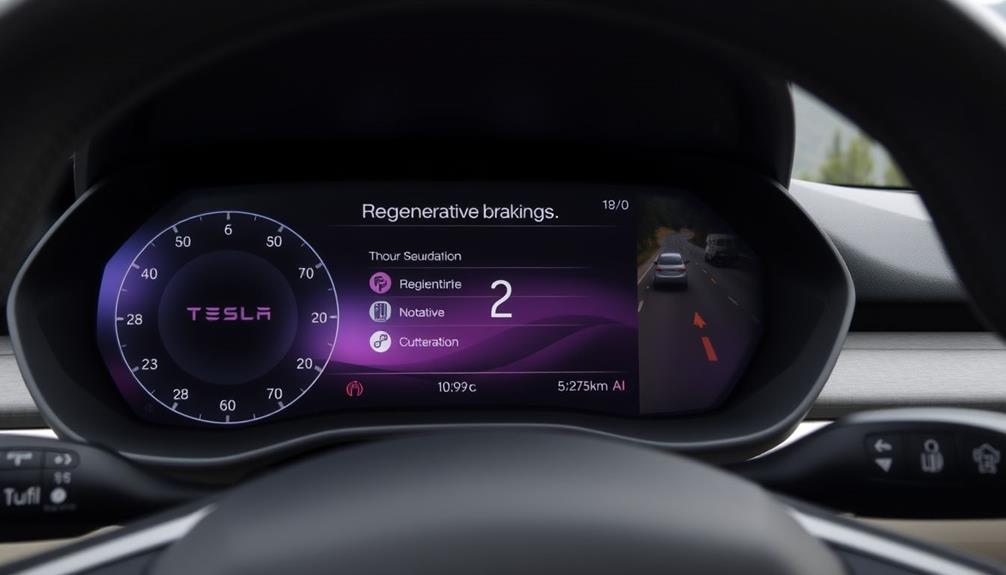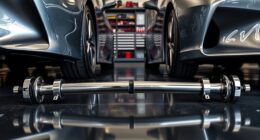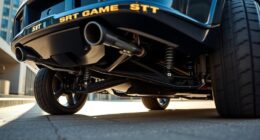You can't completely turn off regenerative braking in a Tesla, but you can adjust its intensity for a more comfortable drive. In older models, simply access the Driving menu on your screen to find options like Low for gentler braking. Newer models don't offer this feature, but they still use regenerative braking to enhance efficiency and extend battery life. Remember, factors like cold weather or a fully charged battery can affect performance. By understanding these variables, you can maximize your driving experience. Keep going to uncover more tips and insights about optimizing regenerative braking in your Tesla!
Key Takeaways
- Regenerative braking cannot be completely disabled in any Tesla model, prioritizing energy recovery and vehicle efficiency.
- Older Tesla models allow adjustment of regenerative braking settings for a gentler experience, while newer models do not.
- Warning indicators alert drivers when regenerative braking is limited due to factors like cold weather or high battery charge.
- Cold temperatures and battery charge over 85% significantly reduce regenerative braking effectiveness, affecting driving performance.
- Drivers can adapt their style to manage regenerative braking, especially in slippery conditions, enhancing control and safety.
Understanding Regenerative Braking
Understanding regenerative braking is essential for maximizing your Tesla's efficiency and driving experience. This innovative system captures kinetic energy during deceleration to recharge your battery, enhancing energy recovery like no traditional braking system can. In fact, Tesla's regenerative braking can recover up to 70% of energy typically lost during braking, which greatly extends your driving range, especially in stop-and-go traffic.
As the demand for sustainable technologies increases, understanding how features like regenerative braking work is becoming more important in the context of AI software engineering jobs, which are focused on developing applications that enhance energy use.
With this feature, you can enjoy a much more seamless driving experience. Tesla's regenerative braking is known for its aggressive nature, providing up to 85kW of power under ideal conditions. However, keep in mind that cold temperatures and a fully charged battery can limit its effectiveness, impacting how much energy you can recover.
One of the most notable advantages of regenerative braking is how it reduces wear on traditional brake components. By relying more on this system, you not only improve your vehicle's efficiency but also extend the life of your brakes.
How to Adjust Regen Settings

If you own an older Tesla model, you can adjust the regenerative braking settings to suit your driving style.
This customization allows for a smoother driving experience, similar to the benefits of airless paint sprayers which provide a smooth finish and reduce project time.
Simply access the main screen, go to settings, and select the Driving menu to switch to Low for a gentler braking experience.
Keep in mind that newer models don't offer this adjustment, so it's important to understand your vehicle's limitations and how they may affect your comfort on the road.
Adjusting Regen in Older Models
Often, you can easily adjust the regenerative braking settings on older Tesla models to better suit your driving preferences, which can enhance your overall driving experience.
By accessing the settings on your main screen and selecting the Driving menu, you can reach these options. This feature allows you to customize your driving experience and enhance comfort, much like how budgeting is essential for financial health.
Here's how you can adjust the regen settings:
- Access Settings: Find the settings icon on your main screen.
- Select Driving Menu: Tap on the Driving menu to access regen options.
- Choose Regenerative Braking: Look for the Regenerative Braking option.
- Set to Low: If you want to reduce effects, set it to Low.
- Personalize Your Experience: Explore other settings to find what feels best for you.
Limitations and Conditions
While you can adjust the regenerative braking settings in older Tesla models to suit your preferences, it's important to be aware of certain limitations and conditions that can affect its performance.
For instance, if you're driving in cold weather or if your battery state of charge exceeds 85%, you might notice a decrease in regenerative braking effectiveness. This is similar to how common causes of heat pump failure can impact efficiency. Warning indicators will alert you to these conditions, so stay attentive.
Although you can't completely disable regenerative braking in any Tesla model, you can set it to Low to limit its effects for enhanced comfort. The "Apply Brakes When Regenerative Braking is Limited" feature is also handy, giving you additional control when regen performance dips.
Keep in mind that once normal conditions are restored, it can take up to half an hour for the regenerative braking system to return to full functionality.
This means you'll need to be proactive in adjusting your driving style during those periods, especially if you rely heavily on regen to maximize efficiency. Understanding these limitations and conditions guarantees you can make the most of your Tesla driving experience.
Limitations of Regenerative Braking

Regenerative braking isn't always at its best, especially in cold temperatures or when your battery's over 85% charged.
This can affect your overall driving experience, similar to how color accuracy impacts overall image quality in home cinema projectors.
You'll notice warning indicators alerting you when the system's effectiveness is limited, so it's vital to pay attention to those signals.
Understanding these limitations can help you adjust your driving habits accordingly.
Temperature Effects on Regen
Tesla's regenerative braking system can face significant limitations in cold temperatures, affecting your driving experience. When the temperature drops, the cold battery struggles to maintain its energy storage capacity, which can reduce the effectiveness of regenerative braking.
In addition, yoga for back pain can also highlight the importance of maintaining a body that's responsive and adaptable to various conditions, much like how your driving habits should adapt to temperature changes.
You'll notice that when the battery is fully charged (over 85%), regenerative braking is limited, preventing you from capturing additional energy during deceleration. Battery management systems may also temporarily disable regenerative braking under extreme cold or high charge conditions, impacting your driving performance.
Here are some key points to reflect on:
- Cold temperatures reduce battery efficiency.
- Regenerative braking is less effective with a cold battery.
- You'll receive warning indicators when regenerative braking is limited.
- Recovery from limitations can take up to half an hour as the battery warms up.
- Driving performance may be affected during these conditions.
Being aware of these temperature effects on regenerative braking can help you adapt your driving habits in colder weather, ensuring you remain informed about your Tesla's performance.
Battery Charge Limitations
When your battery charge exceeds 85%, you'll notice limitations in regenerative braking effectiveness. This happens because the system prioritizes battery health and storage capacity. Fundamentally, the vehicle limits energy recovery to protect your battery, ensuring it lasts longer.
Additionally, temperature plays a considerable role. Cold weather can dramatically reduce regenerative braking performance, as the battery needs to warm up to ideal conditions. In extreme cold or when fully charged, the battery management system may even disable regenerative braking temporarily.
Here's a quick overview of how battery charge and temperature affect regenerative braking:
| Condition | Effect on Regenerative Braking |
|---|---|
| Battery Charge > 85% | Limited effectiveness |
| Cold Temperatures | Reduced performance |
| Battery Fully Charged | Possible temporary disablement |
| Recovery Time | Up to 30 minutes |
Understanding these limitations can help you manage your driving experience more effectively. Keeping an eye on your battery charge and knowing the temperature conditions can greatly enhance your vehicle's regenerative braking performance.
Warning Indicators Explained
Warning lights on your dashboard can be your first clue that regenerative braking isn't working at its best.
When conditions like cold temperatures or a fully charged battery arise, you might notice warning indicators signaling limited regenerative braking. This is due to the battery management systems, which automatically restrict regenerative braking to protect the health of your battery.
It's important to understand that cold medications overview can similarly affect performance under certain conditions, emphasizing the need for awareness in both scenarios.
If you find yourself in this situation, here are some key points to evaluate:
- Cold Weather: Regenerative braking can be less effective in low temperatures.
- Full Battery: A fully charged battery may disable regenerative braking temporarily.
- Apply Brakes: Enabling the "Apply Brakes When Regenerative Braking is Limited" option can enhance your driving experience.
- Recovery Time: It might take up to half an hour for regenerative braking to return to normal.
- Stay Alert: Pay attention to warning indicators, as they help you understand your vehicle's performance.
Driving in Cold Weather

Driving in cold weather can pose unique challenges for electric vehicle owners, particularly regarding regenerative braking. In low temperatures, you might notice that your Tesla's regenerative braking isn't as effective due to reduced battery efficiency and energy storage capacity. This can impact your overall driving experience, especially when maneuvering icy roads.
To help maintain comfort during cold weather, consider using vital oils for respiratory health to promote easier breathing as you drive.
To maximize regenerative braking performance in cold conditions, it's crucial to monitor your battery charge. If your battery is over 85% charged, regenerative braking capabilities will be restricted. Preconditioning the battery before driving can greatly improve its efficiency, allowing for better regen performance.
When driving in cold weather, ease off the accelerator gently to manage regen sensitivity. This approach helps avoid abrupt deceleration, which can be especially jarring on icy roads.
Fortunately, Tesla vehicles come equipped with stability control systems that help mitigate issues associated with excessive regenerative braking, ensuring a safer driving experience in adverse conditions.
Regen on Slippery Roads

When driving on slippery roads, regenerative braking can considerably impact your traction.
Understanding the balance between technology use and creative expression is crucial, especially in challenging driving conditions nurturing an imaginative mindset.
Tesla's recent adjustments, including a hidden snow mode, help you maintain better control and enhance safety in these conditions.
It's vital to understand how these features work to keep your driving experience smooth and secure.
Regen Impact on Traction
Regenerative braking can greatly impact traction, especially on slippery roads. When driving in icy or snowy conditions, you might experience unintended deceleration, leading to a loss of traction.
To help you navigate these challenges, Tesla has implemented various systems to enhance your driving experience, including features that can help mitigate risks associated with risk management strategies for Bitcoin IRAs during your journey.
Here are some key points to keep in mind:
- Use traction control adjustments for better handling.
- Activate the hidden snow mode to manage regenerative braking.
- Pay attention to weather conditions that might affect road traction.
- Gradually ease off the accelerator to maintain control.
- Rely on stability control systems to enhance safety.
It's crucial to understand how regenerative braking interacts with slippery surfaces. When you engage it, you may feel the vehicle slow down more rapidly than expected. This can make it tricky to maintain grip on icy roads.
By being aware of potential loss of traction and utilizing Tesla's features, you can mitigate the risks. Always stay proactive in adjusting your driving style based on current weather conditions to guarantee a safer ride.
Ultimately, understanding these factors will help you make the most of your Tesla's regenerative braking system.
Adjustments for Slippery Conditions
While traversing slippery roads, your Tesla's regenerative braking can pose challenges if not managed properly.
Since Tesla vehicles built after Q2 2020 don't allow you to adjust regenerative braking directly, it's essential to adapt your driving style, especially during winter conditions.
One effective strategy is to utilize the traction control adjustments introduced in 2022, which enhance handling on icy and snowy surfaces.
Additionally, activating the hidden snow mode can help manage regenerative braking performance, making your drive safer by reducing regen intensity.
Another valuable tip is to precondition the battery. This process can greatly improve regenerative braking performance in cold temperatures, enhancing overall safety and efficiency while driving.
Community feedback suggests easing off the accelerator gradually can also help control regenerative braking sensitivity on icy surfaces, promoting smoother deceleration and preventing sudden slips.
Safety Features Overview
During winter months, understanding the safety features of your Tesla can greatly enhance your driving experience on slippery roads.
The combination of regenerative braking, traction control, and stability control works together to provide a safer driving environment, especially in icy conditions. However, you should use these features with caution.
Here are some key safety features to keep in mind:
- Enhanced Traction Control: Adjusts to improve handling on slippery surfaces.
- Snow Mode: A hidden feature that modifies regenerative braking for better management in adverse weather.
- Stability Control: Works alongside regenerative braking to help maintain traction.
- Driver Awareness: Stay alert and adjust your driving habits accordingly when conditions worsen.
- Video Resources: Utilize available videos to learn how to optimize snow mode for winter driving.
Community Feedback on Regen

The discomfort many Tesla owners feel with aggressive regenerative braking has sparked vibrant discussions within the community. Many drivers report a learning curve when adapting to this feature, often finding it uncomfortable at first. However, this discomfort typically resolves after a few days of driving.
Still, there's a strong desire among users for Tesla to reinstate adjustable regenerative braking settings. Community feedback emphasizes the importance of customization, as some owners would even pay to activate features that allow greater control over regeneration.
To help mitigate discomfort, users have suggested utilizing "Chill mode." This setting can provide a smoother driving experience, especially for sensitive passengers.
Members of the Tesla Motors Club share their experiences and tips, creating a collaborative environment where drivers can learn from one another.
Future of Regenerative Braking

As discussions about regenerative braking evolve, the future of this technology in Tesla vehicles looks promising. The trend towards standardization may be shifting, but consumer preferences remain clear. Many drivers want customizable regenerative braking settings to enhance their driving experience, allowing for greater control and comfort.
Here are some key aspects shaping the future of regenerative braking:
- Enhanced battery technology: Innovations will likely improve energy recuperation efficiency.
- Increased consumer input: Community feedback is essential in shaping future software updates and features.
- Broader EV adoption: Other automakers are likely to follow Tesla's lead, integrating regenerative braking in their models.
- Focus on efficiency: Standardization could streamline features, making them more user-friendly.
- Potential for new features: As technology advances, expect innovative approaches to regenerative braking.
The evolution of regenerative braking not only reflects technological advancements but also highlights the significance of listening to consumer preferences.
With ongoing feedback and improvements, Tesla is poised to lead in the domain of regenerative braking, ensuring a more efficient and enjoyable driving experience for all.
Techniques for Smooth Driving

Achieving smooth driving in a Tesla equipped with regenerative braking involves mastering a few key techniques. First, practice gradually easing off the accelerator instead of abruptly releasing it. This approach minimizes sudden deceleration effects, leading to a more comfortable ride.
If you want to enhance comfort for sensitive passengers, consider using the "Chill mode." This setting provides a more gradual acceleration and braking response, making for a smoother driving experience.
To familiarize yourself with regenerative braking, spend time practicing in low-traffic areas. This will help you adapt your driving techniques based on how the system responds.
Also, always be mindful of environmental conditions like cold temperatures, which can affect regenerative braking's effectiveness. In such situations, you'll want to drive more cautiously.
Incorporating traditional braking techniques, especially when driving downhill or on inclines, is essential. This combination guarantees safe stopping while still maximizing the benefits of regenerative braking when needed.
Importance of Battery Preconditioning

Optimizing your Tesla's performance goes beyond mastering driving techniques; it also involves understanding the importance of battery preconditioning.
When you precondition your battery, especially in cold temperatures, you set the stage for improved regenerative braking performance. This process helps warm the battery, allowing it to operate at its ideal temperature, which greatly enhances energy recovery during deceleration.
Here are some key benefits of battery preconditioning:
- Guarantees effective energy recovery during braking.
- Mitigates limitations on regenerative braking in cold weather.
- Maximizes battery efficiency for longer range.
- Prepares the battery for peak performance before driving.
- Can be automated or manually activated for convenience.
Maintenance of Braking Systems

While you may focus on enjoying the drive, maintaining your Tesla's braking system is vital for your safety and performance. Regular inspection of brake pads is important, typically recommended every 20,000 to 50,000 miles. This practice not only helps prevent costly repairs but also guarantees maximum braking efficiency, which can greatly affect your stopping distances.
Pay attention to signs of worn brake pads, such as squeaking or grinding noises, vibrations during braking, and warning lights on the dashboard. Ignoring these signals can lead to reduced braking efficiency and may increase the risk of brake system failure.
Additionally, make it a point to clean and lubricate your brake calipers annually or every 12,500 miles. This simple maintenance step improves performance and prolongs the life of your braking system.
Neglecting the maintenance of braking systems can result in serious consequences, including longer stopping distances and a heightened risk of accidents.
Frequently Asked Questions
Can You Turn off Regenerative Braking in a Tesla?
You can't turn off regenerative braking in newer Tesla models, as it's set by default to enhance efficiency. In older models, you can adjust it, but complete disabling isn't possible.
Is Tesla Regenerative Braking Always On?
Regenerative braking captures about 70% of the energy normally lost during deceleration. Yes, Tesla's regenerative braking is always on, enhancing efficiency and safety, even if cold temperatures or a full battery limit its effectiveness.
Can You Adjust Tesla Regenerative Braking?
You can adjust regenerative braking in older Tesla models by steering to the Driving menu on the main screen. However, models built after Q2 2020 have fixed settings, so adjustments aren't possible.
Can You Turn off One Pedal Driving a Tesla?
Did you know that about 60% of Tesla drivers adapt to one-pedal driving? Unfortunately, you can't completely turn it off in newer models, but you can adjust the braking intensity for a customized experience.
Conclusion
In the world of Tesla driving, regenerative braking transforms your ride into a seamless dance with the road, harnessing energy with every glide. While you can tweak its settings, imagine the thrill of effortlessly cruising, feeling the gentle pull as it slows you down. Embrace the chilly mornings and slick streets, knowing your Tesla's smart enough to adapt. With a little care and attention, you'll not only enhance your driving experience but also keep your battery humming harmoniously.










